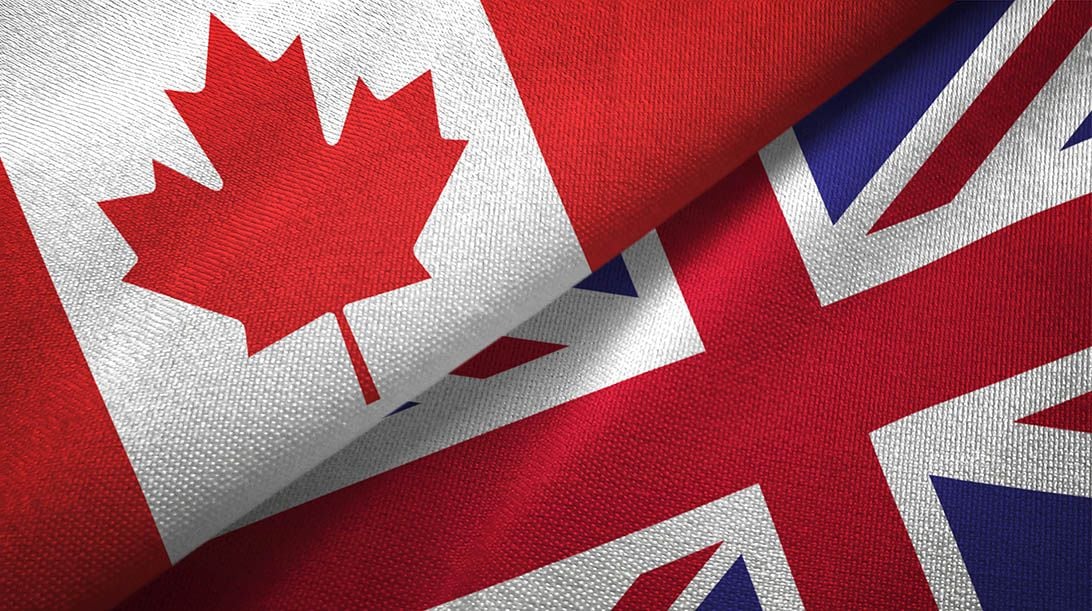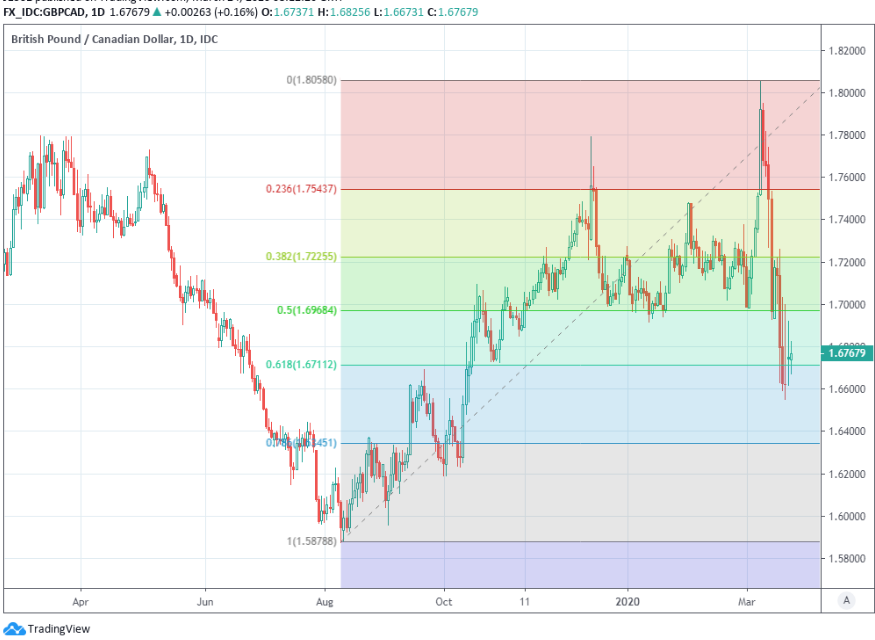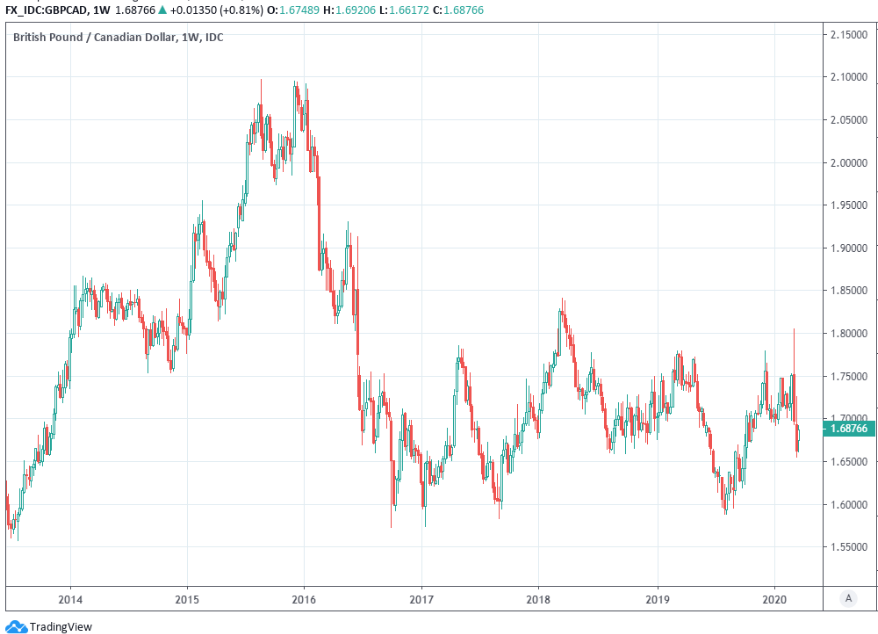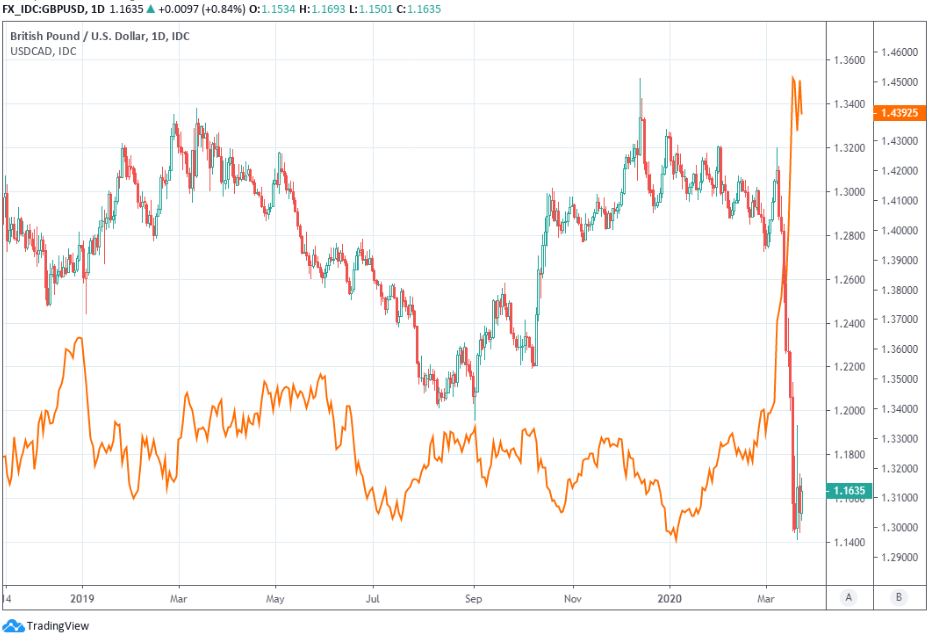Pound-to-Canadian Dollar Rate Steadies after Sterling Trades Places with Loonie
- Written by: James Skinner
- GBP/CAD steadies above key technical level on charts.
- GBP/CAD gains come amid global recovery of risk assets.
- Price action underlines role reversal between GBP and CAD.
- GBP lacks obvious support until 1.6345, once below 1.6711.

Image © Adobe Stock
GBP/CAD Spot rate: 1.6840, +0.32% on publication
- Indicative bank rates for transfers: 1.6253-1.6371
- Transfer specialist indicative rates: 1.6590-1.6691 >> Get your quote now
The Pound-to-Canadian Dollar rate was stabilising above a key level on the charts Tuesday even after the UK entered its first day of a so-called 'lockdown,' although it might need the improved mood music in the market to endure in order to avoid fresh losses over the coming days.
Sterling suffered of its heaviest losses for decades against some rivals last week and ceded ground to an outperforming Canadian Dollar for a second time running, although it recovered the 61.8% Fibonacci retracement of the 2019 uptrend ahead of the Friday close and has steadied around there this week. The Pound-to-Canadian Dollar rate remaining above the 1.6711 level keeps the six-month uptrend intact.
The Pound and other risk assets were lifted Tuesday by an improvement in risk appetite after China announced the end of a 'lockdown' in its Hubei province and European countries reported slower growth in the spread of coronavirus at the weekend, reflecting a recent and ongoing reversal of roles between Sterling and the Loonie. Stock markets and the price of oil were higher on Tuesday while many bond yields also rose, although not Canada's.
Above: Pound-to-Canadian Dollar rate at daily intervals. Finding support around 61.8% retracement of August uptrend.
"We now have a more neutral stance. It is likely that markets have not fully digested the upcoming economic downturn, but some pockets of value have started to emerge. In the coming weeks, too, we should see some encouraging results from the drastic measures that have been taken to contain the outbreak. This does not warrant an outright negative view on risk assets, nor is there enough conviction to significantly increase the weight of these riskier asset classes," says Jeroen Blokland, a multi-asset portfolio manager at Robeco.
Price action came with the UK entering the first day of a so-called lockdown in which citizens are expected to remain indoors except for in certain circumstances. Prime Minister Boris Johnson could have the legal authority to enforce the 'order' as soon as Thursday when his coronavirus bill is expected to clear the legislative gauntlet, giving him and ministers unprecedented powers for up to two years in which law could be made and enforced without debate or scrutiny in parliament.
Sterling normally has an advantage over the Canadian Dollar in times of risk aversion due to the Loonie's sensitivity to the price of oil, Canada's largest export, and has typically ceded ground to it when the market mood music brightens. But the British currency has been undermined of late by its large current account deficit, which has seen it underperform even the Loonie in times of risk aversion and will leave the Pound-to-Canadian Dollar rate vulnerable to any deterioration in market sentiment.
Above: Pound-to-Canadian Dollar rate at weekly intervals.
"It is currently disliked by investors and has traded somewhat in tandem with G10 commodity currencies," says Morten Lund, an economist at Nordea Markets, of the Pound. "The UK has a twin deficit with the biggest current account deficit (as % of GDP) in G10. A constant capital inflow is therefore needed to underpin the GBP which is challenging in the present “dash for cash.”
The UK's current account deficit, government reluctance to implement a national 'coronavirus' lockdown and generally strong demand for the U.S. Dollar have weighed heavier on Sterling of late than the economic woes of Canada have for the Loonie. Those concerns could drag the currency lower again if market sentiment deteriorates, while facilitating a recovery for the length of time that investors remain upbeat and risk assets like stocks and oil are stable.
“The perfect storm of an exponential rise in volatility coupled with the deterioration in USD funding/liquidity conditions places the focus squarely on the current account debtor nations and their ability to finance that deficit,” says Kamal Sharma, a strategist at BofA Global Research. “This process cannot go on ad infinitum and our focus will be on whether the pace of GBP/USD selling starts to abate. There are signs, albeit tentative that GBP/USD selling has slowed in the US session. Providing month-end passes without incidence, we think GBP/USD could gravitate back towards $1.20.”
Deficit and virus concerns have seen Sterling fall further against the U.S. Dollar than its Canadian counterpart, which matters because the Pound-to-Canadian Dollar rate is simply the sum of GBP/USD over CAD/USD. Sterling now needs the GBP/USD rate to outpace any decline in USD/CAD to avoid falling back below 1.6711, which is the 61.8% Fobonacci rectracement of the 2019 uptrend. Once below 1.6711 there is a distinct lack of any obvious technical support for the exchange rate until 1.6345.
Above: GBP/USD rate shown at daily intervals alongside USD/CAD rate (orange line).







